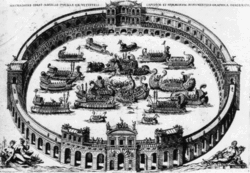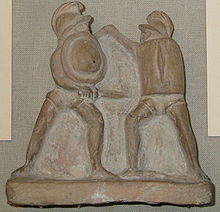Inaugural games of the Colosseum
The inaugural games were held, on the orders of the Roman Emperor Titus, to celebrate the completion in AD 80 (81 according to some sources)[1] of the Colosseum, then known as the Flavian Amphitheatre (Latin: Amphitheatrum Flavium).
Titus' reign began with months of disasters – including the Eruption of Mount Vesuvius in 79 AD, a fire in Rome, and an outbreak of plague – he inaugurated the completion of the structure with lavish games that lasted for more than one hundred days, perhaps in an attempt to appease the Roman public and the gods.
Naval battles formed part of the spectacles but whether these took place in the amphitheatre or on a lake that had been specially constructed by Augustus is a topic of debate among historians.
The works of Suetonius and Cassius Dio focus on major events, while Martial provides some fragments of information on individual entertainments and the only detailed record of a gladiatorial combat in the arena known to survive: the fight between Verus and Priscus.
The site became available to Nero by the Great Fire of Rome in AD 64 and redeveloped for his personal enjoyment with the construction of a huge artificial lake in the Domus Aurea, and a colossal statue of himself.
[4] By the time the amphitheatre was completed, Titus's short reign had already endured a series of disasters: two months after he had succeeded Vespasian, Mount Vesuvius had erupted, destroying Pompeii, Herculaneum, Stabiae, and Oplontis; a fire had burned in the city of Rome for three days and three nights causing substantial damage and destroying the Temple of Jupiter that had recently been restored by Vespasian; and there had been an outbreak of plague which was said to be the worst the city had ever endured.
[5] To dedicate the amphitheatre and the baths, and probably in an attempt to mollify both the Roman public and the gods, Titus inaugurated the opening of the Colosseum with lavish games which lasted for more than a hundred days.
The poet Martial gives the most complete and only truly contemporary account in the form of his De Spectaculis ("On the Spectacles"), a somewhat sycophantic series of epigrams detailing the individual events of the games as an illustration of Titus' power and benevolence.
Much of the work is concerned with praising Titus, and there have been difficulties with authenticating, dating and translating various portions, but Martial does give details of events not covered by other sources and the only known surviving complete record of a gladiatorial combat in the arena.
[15] He also mentions a bull enraged by fires in the amphitheatre being tossed around the arena before being killed by an elephant,[16] but there is nothing to indicate that these two epigrams are about the same events or repeated many times during the span of one hundred days of celebration.
Intended to face a company of men armed with spears and a host of other animals, it had to be goaded by "trembling trainers" until it would engage the other combatants:[c] ...at length the fury we once knew returned.
[20]Carpophorus was a skilled bestiarius, specializing in fighting animals in the arena, and is mentioned again by Martial, who compares him to Hercules[21] and praises his abilities in dispatching a bear, a leopard and a lion of "unprecedented size".
[23] Carpophorus was not the only beast slayer worthy of mention: another of Martial's epigrams refers to a woman equalling Hercules's feat of slaying the Nemean Lion.
Although the executions were seen as symbolizing Rome's power, the higher classes normally took advantage of this interval to leave the arena to dine; the Emperor Claudius was criticised by some authors for not doing so,[28] so it is unlikely that Titus would have watched this part of the show.
[29] These executions often took the form of the re-creation of some tragic scene from history or mythology with the criminal cast in the role of the victim killed by wild beasts.
Finally he met with the punishment he deserved; the guilty wretch had plunged a sword into his father's throat or his master's, or in his madness had robbed a temple of its secret gold, or laid a cruel torch to Rome.
[33] Ironic reinterpretations of the myths may have been popular:[34] in addition to Orpheus' failure to charm the beasts, Martial mentions Daedalus being torn apart by another bear, mocking him with the words "how you must wish you had your feathers now".
[36] Nero had provided a similar entertainment at an event he had staged using an actor dressed in the costume of a bull,[2] though Martial claims that the act performed at the inaugural games was authentic.
Dio, Suetonius and Martial all record naumachiae, the commonly used Greek term for what the Romans also called navalia proelia, re-creations of famous sea battles.
Suetonius writes that Titus' brother and successor, Domitian, staged sea-fights in the amphitheatre,[39] but he had made alterations to the structure, which probably included adding the hypogeum—a complex of underground passages that may have allowed the arena to be quickly flooded and emptied.
He also brought in people on ships, who engaged in a sea-fight there, impersonating the Corcyreans and Corinthians; and others gave a similar exhibition outside the city in the grove of Gaius and Lucius, a place which Augustus had once excavated for this very purpose.
Dio states this took place on the first day, with the lake covered over with planking and wooden stands erected around it,[10] while Suetonius says the events occurred in the basin after the water had been let out.
[10] One fight, between the gladiators Verus and Priscus, was recorded by Martial: While Priscus continued to draw out the contest, and Verus likewise, and for a long time the struggle was evenly balanced on both sides, discharge was demanded for the stout fighters with loud and frequent shouting; but Caesar obeyed his own law (the law was that once the palm had been set up the fight had to proceed until a finger was raised): he did as he was allowed, making frequent awards of plate.
It seems to imply that a draw was uncommon in gladiatorial combat at this level, but that Titus eventually yielded to the wishes of the crowd, declared the match equal, and granted both men their freedom (with the traditional presentation of the wooden sword).
[47] Martial's mention of gift-giving is repeated in the account by Dio, who says that Titus would throw wooden balls into the crowd from his seat in the box at the north end of the arena.
These balls were inscribed with a description of a gift, either food, clothing, slaves, pack animals, horse, cattle, or gold or silver vessels.





